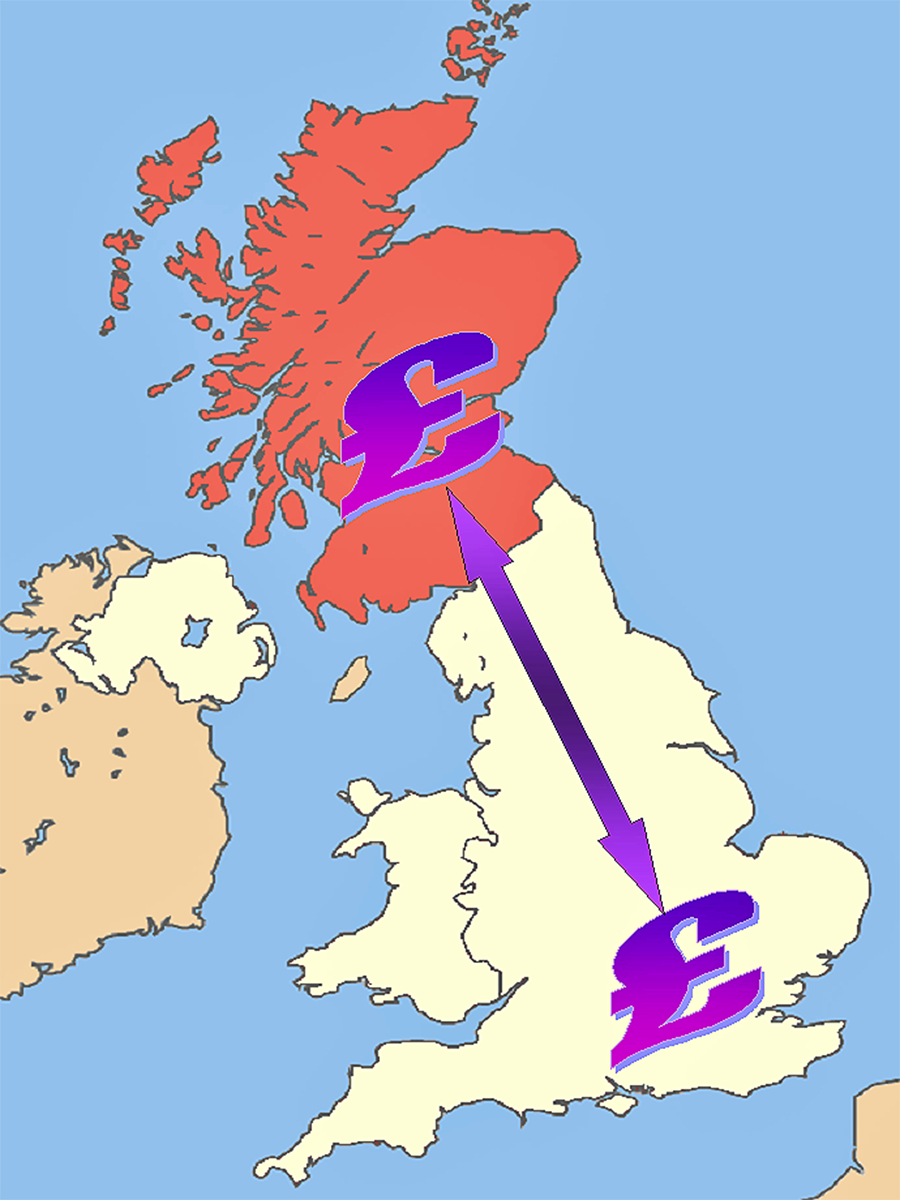 Economic journalists, commentators and politicians have been examining the possible economic effects of a Yes vote in the Scottish independence referendum on 18 September. For an economist, there are two main categories of difficulty in examining the consequences. The first is the positive question of what precisely will be the consequences. The second is
Economic journalists, commentators and politicians have been examining the possible economic effects of a Yes vote in the Scottish independence referendum on 18 September. For an economist, there are two main categories of difficulty in examining the consequences. The first is the positive question of what precisely will be the consequences. The second is  the normative question of whether the likely effects will be desirable or undesirable and how much so.
the normative question of whether the likely effects will be desirable or undesirable and how much so.
The first question is largely one of ‘known unknowns’. This rather strange term was used in 2002 by Donald Rumsfeld, US Secretary of Defense, in the context of intelligence about Iraq. The problem is a general one about forecasting the future. We may know the types of thing that are likely happen, but the magnitude of the outcome cannot be precisely known because there are so many unknowable things that can influence it.
Here are some known issues of Scottish independence, but with unknown consequences (at least in precisely quantifiable terms). The list is certainly not exhaustive and you could probably add more questions yourself to the list.
|
|
| • |
Will independence result in lower or higher economic growth in the short and long term? |
| • |
Will there be a currency union, with Scotland and the rest of the UK sharing the pound and a central bank? Or will Scotland merely use the pound outside a currency union? Would it prefer to have its own currency or join the euro over the longer term? |
| • |
What will happen to the sterling exchange rate with the dollar, the euro and various other countries? |
| • |
How will businesses react? Will independence encourage greater inward investment in Scotland or will there be a net capital outflow? And either way, what will be the magnitude of the effect? |
| • |
How will assets, such as oil, be shared between Scotland and the rest of the UK? And how will national debt be apportioned? |
| • |
How big will the transition costs be of moving to an independent Scotland? |
| • |
How will independence impact on Scottish trade (a) with countries outside the UK and (b) with the rest of the UK? |
| • |
What will happen about Scotland’s membership of the EU? Will other EU countries, such as Spain (because of its concerns about independence movements in Catalonia and the Basque country), attempt to block Scotland remaining in or rejoining the EU? |
| • |
What will happen to tax rates in Scotland, with the new Scottish government free to set its own tax rates? |
| • |
What will be the consequences for Scottish pensions and the Scottish pensions industry? |
| • |
What will happen to the distribution of income in Scotland? How might Scottish governments behave in terms of income redistribution and what will be its consequences on output and growth? |
Of course, just because the effects cannot be known with certainty, attempts are constantly being made to quantify the outcomes in the light of the best information available at the time. These are refined as circumstances change and newer data become available.
 But forecasts also depend on the assumptions made about the post-referendum decisions of politicians in Scotland, the rest of the UK and in major trading partner countries. It also depends on assumptions about the reactions of businesses. Not surprisingly, both sides of the debate make assumptions favourable to their own case.
But forecasts also depend on the assumptions made about the post-referendum decisions of politicians in Scotland, the rest of the UK and in major trading partner countries. It also depends on assumptions about the reactions of businesses. Not surprisingly, both sides of the debate make assumptions favourable to their own case.
Then there is the second category of question. Even if you could quantify the effects, just how desirable would they be? The issue here is one of the weightings given to the various costs and benefits. How would you weight distributional consequences, given that some people will gain or lose more than others? What social discount rate would you apply to future costs and benefits?
Then there are the normative and largely unquantifiable costs and benefits. How would you assess the desirability of political consequences, such as greater independence in decision-making or the break-up of a union dating back over 300 years? But these questions about nationhood are crucial issues for many of the voters.
Articles
Scottish Independence would have Broad Impact on UK Economy NBC News, Catherine Boyle (9/9/14)
Scottish independence: the economic implications The Guardian, Angela Monaghan (7/9/14)
Scottish vote: Experts warn of potential economic impact BBC News, Matthew Wall (9/9/14)
The economics of Scottish independence: A messy divorce The Economist (21/2/14)
Dispute over economic impact of Scottish independence Financial Times, Mure Dickie, Jonathan Guthrie and John Aglionby (28/5/14)
10 economic benefits for a wealthier independent Scotland Michael Gray (6/3/14)
Scottish independence, UK dependency New Economics Foundation (NEF), James Meadway (4/9/14)
Scottish Jobs and the World Economy Scottish Economy Watch, Brian Ashcroft (25/8/14)
Scottish yes vote: what happens to the pound in your pocket? Channel 4 News (9/9/14)
What price Scottish independence? BBC News, Robert Peston (12/9/14)
What price Scottish independence? BBC News, Robert Peston (7/9/14)
Economists can’t tell Scots how to vote BBC News, Robert Peston (16/9/14)
Books and Reports
The Economic Consequences of Scottish Independence Scottish Economic Society and Helmut Schmidt Universität, David Bell, David Eiser and Klaus B Beckmann (eds) (August 2014)
The potential implications of independence for businesses in Scotland Oxford Economics, Weir (April 2014)
Questions
- What is a currency union? What implications would there be for Scotland being in a currency union with the rest of the UK?
- If you could measure the effects of independence over the next ten years, would you treat £1m of benefits or costs occurring in ten years’ time the same as £1m of benefits and costs occurring next year? Explain.
- Is it inevitable that events occurring in the future will at best be known unknowns?
- If you make a statement that something will occur in the future and you turn out to be wrong, was your statement a positive one or a normative one?
- What would be the likely effects of Scottish independence on the current account of the balance of payments (a) for Scotland; (b) for the rest if the UK?
- How does inequality in Scotland compare with that in the rest of the UK and in other countries? Why might Scottish independence lead to a reduction in inequality? (See the chapter on inequality in the book above edited by David Bell, David Eiser and Klaus B Beckmann.)
- One of the problems in assessing the arguments for a Yes vote is uncertainty over what would happen if there was a majority voting No. What might happen in terms of further devolution in the case of a No vote?
- Why is there uncertainty over the amount of national debt that would exist in Scotland if it became independent?
 Japan’s general election on 16 December was won by the centre-right Liberal Democratic Party (LDP), led by Shinzo Abe. It gained a two-thirds majority in the lower house. It returns to power after losing to the Democratic Party in 2009. Previously it had been in office for most of the time since 1955.
Japan’s general election on 16 December was won by the centre-right Liberal Democratic Party (LDP), led by Shinzo Abe. It gained a two-thirds majority in the lower house. It returns to power after losing to the Democratic Party in 2009. Previously it had been in office for most of the time since 1955.
The LDP has promised to revive the flagging Japanese economy, which has been suffering from years of little or no growth and returned to recession last quarter. Economic confidence has been damaged by a dispute with China about the sovereignty over some small islands in the East China Sea. The economy, whose exports make up some 13% of GDP, has suffered from the global slowdown and a high yen. The yen has appreciated against the dollar by around 40% since 2007.
The economy has also suffered from the shutdown of all its nuclear reactors following the earthquake and tsunami last year. Nuclear power accounted for over 30% of the country’s electricity generation.
 Mr Abe promises to revive the economy through fiscal and monetary policies. He plans a fiscal stimulus package in early 2013, with increased government expenditure on infrastructure and other public-works. He also wants the Bank of Japan to increase its inflation target from 1% to 3% and to achieve this through various forms of monetary easing.
Mr Abe promises to revive the economy through fiscal and monetary policies. He plans a fiscal stimulus package in early 2013, with increased government expenditure on infrastructure and other public-works. He also wants the Bank of Japan to increase its inflation target from 1% to 3% and to achieve this through various forms of monetary easing.
The initial reactions of markets to the election result were favourable. The stock market rose and the yen fell.
However, as the following articles discuss, there are dangers associated with Mr Abe’s policies. The expansionary fiscal policy will lead to a rise in the country’s general-government debt, which, at some 240% of GDP, is by far the largest in the developed world. This could lead to a loss of confidence in Japanese debt and a fall in the price of bonds on the secondary markets and a rise in government borrowing costs. Also, a depreciation of the yen, while welcomed by exporters, would increase the price of imports, including food and raw materials.
Changing of guard in Japan as PM concedes vote CNN, Yoko Wakatsuki, Brian Walker, and Hilary Whiteman (17/12/12)
LDP Win Clears Pipes for Japan Fiscal Spigot Bloomberg Businessweek, Toru Fujioka (17/12/12)
Economic implications of Japan’s election Huffington Post (16/12/12)
Japan economy contracts again Taipei Times (11/12/12)
Japan elections: Shares rise and yen weakens on Abe win BBC News (17/12/12)
Shinzo Abe’s challenges in reviving Japan’s economy BBC News, Puneet Pal Singh (17/12/12)
Can Shinzo Abe Save Japan? Slate, Matthew Yglesias (30/11/12)
Deflation only natural when politicians refuse to fix oversupplied Japan Japan Times, Teruhiko Mano (17/12/12)
New Year messages from Japan BBC News, Stephanie Flanders (18/12/12)
Japan – Muddling On Or Growing Stronger? Seeking Alpha, Anthony Harrington (12/12/12)
Japanese government unveils £138bn stimulus package The Guardian (11/1/13)
Questions
- Using macroeconomic data from sources such as sites 6, 7 and 9 in the Economics Network’s Economic Data freely available online, describe Japan’s macroeconomic situation over the past 10 years.
- Why has the Japanese yen appreciated so much in recent years?
- What forms could monetary easing take in Japan?
- Why might it prove difficult to stimulate the Japanese economy through fiscal and monetary policies?
- What undesirable side-effects might result from expansionary fiscal and monetary policies?
- What structural weaknesses are there in the Japanese economy that have hindered economic growth? What policies might the new Japanese government pursue in tackling these structural weaknesses?
 Figures released by the Bank of England show that M4 fell by 5.0% in the year to March 2012. This record fall comes despite over £320 billion of assets purchased by the Bank under its quantitative easing programme. These are funded by the creation of reserves in the Bank of England. (See the Bank of England site for details of the timing and amounts of QE.)
Figures released by the Bank of England show that M4 fell by 5.0% in the year to March 2012. This record fall comes despite over £320 billion of assets purchased by the Bank under its quantitative easing programme. These are funded by the creation of reserves in the Bank of England. (See the Bank of England site for details of the timing and amounts of QE.)
Because of the considerable injection of new money into the banking system, notes and coin plus banks’ reserve balances in the Bank of England rose by 44.9%. So how is it that this measure of narrow money has increased massively and yet M4 has fallen?
One problem with using figures for changes in M4 to gauge economic activity is that they include intra-financial sector transactions – transactions between ‘other financial corporations’ (OFCs). Such transactions do not impact on the real economy. For this reason, the Bank of England prefers to focus on a measure that excludes these transactions between OFCs, a measure known as ‘M4 excluding intermediate OFCs’. This measure rose by 2.7% in the year to March 2012. Although this was positive, it was still weak.
So why does quantitative easing seem to be having such a small effect on bank lending? The following articles look at the issue.
Articles
Record collapse in UK money supply blamed on banks The Telegraph, Philip Aldrick (2/5/12)
UK March mortgage approvals rise unexpectedly London South East (2/5/12)
UK March Net Consumer Lending +GBP1.4 Billion NASDAQ, Jason Douglas and Nicholas Winning (2/5/12)
M4 Hits Record Low; Non-Residents Sell Gilts Market News International (2/5/12)
Data
Bankstats (Monetary & Financial Statistics) – March 2012 Bank of England (2/5/12): see Tables A1.1.1, A2.1.1 and A2.2.3
Questions
- How does quantitative easing impact on the narrow measure of money: notes, coin and banks’ reserve balances in the Bank of England?
- How might an increase in narrow money lead to an increase in broad money (such as M4)?
- How is it that notes, coin and banks’ reserve balances rose so rapidly in the year to March 2012, while M4 fell and even M4 excluding OFCs rose only slightly?
- Does this suggest that money supply is endogenous? Explain.
- How does requiring banks to rebuild their capital base impact on the relationship between narrow and broad money?
 Australia was one of the few economies that seemed to be somewhat insulated from the 2008/09 recession and credit crunch. However, with the UK now back in recession and global economic conditions worsening in much of Europe, Australia has now joined the list of countries that are experiencing economic conditions that are ‘weaker than forecast’.
Australia was one of the few economies that seemed to be somewhat insulated from the 2008/09 recession and credit crunch. However, with the UK now back in recession and global economic conditions worsening in much of Europe, Australia has now joined the list of countries that are experiencing economic conditions that are ‘weaker than forecast’.
Today’s world involves economies that are increasingly interdependent, hence the spread of the world economic slowdown. As such, with weak global demand, Australia has started to feel the effects, with demand for its goods and raw materials falling. This has led Australia’s central bank – the Reserve Bank of Australia – to cut its key interest rate (the ‘cash rate’) by more than expected. The rate had been at 4.25% and it was widely believed that a 0.25 percentage point cut would occur. However, the central bank cut the cash rate rate to 3.75% to counter the weakening conditions. The Reserve Bank said:
“This decision is based on information received over the past few months that suggests that economic conditions have been somewhat weaker than expected, while inflation has moderated …Growth in the world economy slowed in the second half of 2011, and is likely to continue at a below-trend pace this year.”
Banks’ interest rates have been falling in Australia for the past few months and this latest cut will do much to help financially squeezed households. Data show that Australian house sales have fallen, as have house prices, and retail sales have fared little better.
Lower interest rates are often a tool used to steer inflation and the Australian central bank may not have been as willing to cut rates had the inflation rate not come down in recent months. Keeping consumer prices under control remains a top priority for the central bank and so it will be interesting to see the impact that these rate cuts will have on the Australian economy.
Articles
Australia cenbank surprises with aggressive half point rate cut Reuters, Wayne Cole (1/5/12)
Australia cuts rates by than forecast to 3.75% BBC News (1/5/12)
Banks unlikely to pass on full rate cut The Australian, Wall Street Journal, Peter Trute (1/5/12)
Australia cuts rate to support economy Financial Times, Neil Hume (1/5/12)
Australia slashes interest rates by 0.5pc to boost economy The Telegraph (1/5/12)
Australia cuts interest rates as economy slows Guardian, Phillip Inman (1/5/12)
Banks must pass on rate cut: businesses Sydney Morning Herald, Ehssan Veiszadeh (1/5/12)
Bond prices rally after rate cut Sydney Morning Herald (1/5/12)
Surplus remains appropriate: Swan Sydney Morning Herald, Colin Brinsden (1/5/12)
Webcasts
 Reserve Bank of Australia Cuts Rates by 50 Basis Points to 3.75% CNBC video, Lauren Rosborough (1/5/12)
Reserve Bank of Australia Cuts Rates by 50 Basis Points to 3.75% CNBC video, Lauren Rosborough (1/5/12)
 Further `Modest’ RBA Easing Possible, ANZ Says Bloomberg, Tony Morriss (1/5/12)
Further `Modest’ RBA Easing Possible, ANZ Says Bloomberg, Tony Morriss (1/5/12)
 Australia’s central bank shifts focus to growth BBC News, Duncan Kennedy (1/5/12)
Australia’s central bank shifts focus to growth BBC News, Duncan Kennedy (1/5/12)
Questions
- Which factors will a central bank consider when setting interest rates?
- Explain the components of aggregate demand that will be affected by a lower rate of interest.
- Using diagrams to illustrate the process, explain both the interest-rate and the exchange-rate transmission mechanisms of the fall in interest rates.
- How are interest rates used to target inflation?
- How will lower rates of interest help the Australian economy recover from weakening global economic conditions?
- Why are Australia’s banks unlikely to pass on the full rate cut to consumers?
- Why did bond prices rise and the Australian dollar depreciate after the rate cut? Why does this suggest that a 0.5% cut was greater than anticpated by markets?
Hyperinflation in Zimbabwe is no longer news. Indeed the news below that inflation has risen to 2,200% may not even surprise us any more. However, inflation of this level should also mean similar changes in the exchange rate if purchasing power parity is to be maintained. The official exchange rate in Zimbabwe, however, hasn’t changed by anywhere near this amount and there are reports (See Scotsman article below) that the Governor of the Central Bank has even tried to portray a recent devaluation as not really a devaluation at all!
Our mutual friend The Economist (subscription) (12/4/07)
Zimbabwe inflation reaches 2,200% BBC News Online (26/4/07)
Zimbabwe’s inflation rate surges to 231,000,000% Guardian (9/10/08)
A month ago, the hospitals were overflowing. Now they lie empty Guardian (6/12/08)
Hyperinflation in Zimbabwe Wikipedia
(27/4/07)
How Zimbabwe lost control of inflation Newzimbabwe.com (11/12/09)
Questions
| 1. |
Explain, using diagrams as appropriate, how hyperinflation will affect the exchange rate in Zimbabwe. |
| 2. |
Discuss the likely economic impact of not devaluing the official exchange rate in line with the level of inflation in Zimbabwe. |
| 3. |
Assess possible exchange rate policies that would help reduce the level of hyperinflation in Zimbabwe. |
 Economic journalists, commentators and politicians have been examining the possible economic effects of a Yes vote in the Scottish independence referendum on 18 September. For an economist, there are two main categories of difficulty in examining the consequences. The first is the positive question of what precisely will be the consequences. The second is
Economic journalists, commentators and politicians have been examining the possible economic effects of a Yes vote in the Scottish independence referendum on 18 September. For an economist, there are two main categories of difficulty in examining the consequences. The first is the positive question of what precisely will be the consequences. The second is  the normative question of whether the likely effects will be desirable or undesirable and how much so.
the normative question of whether the likely effects will be desirable or undesirable and how much so. But forecasts also depend on the assumptions made about the post-referendum decisions of politicians in Scotland, the rest of the UK and in major trading partner countries. It also depends on assumptions about the reactions of businesses. Not surprisingly, both sides of the debate make assumptions favourable to their own case.
But forecasts also depend on the assumptions made about the post-referendum decisions of politicians in Scotland, the rest of the UK and in major trading partner countries. It also depends on assumptions about the reactions of businesses. Not surprisingly, both sides of the debate make assumptions favourable to their own case.



